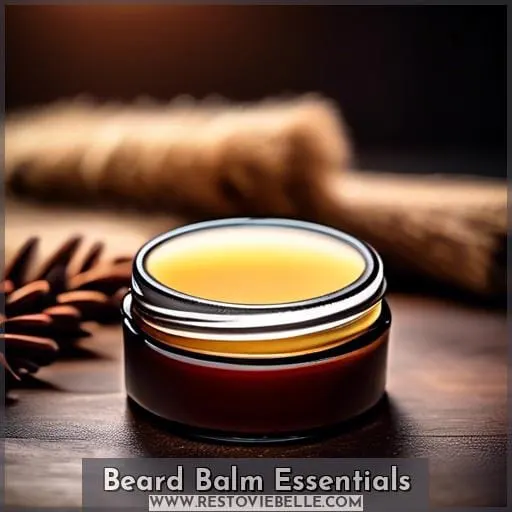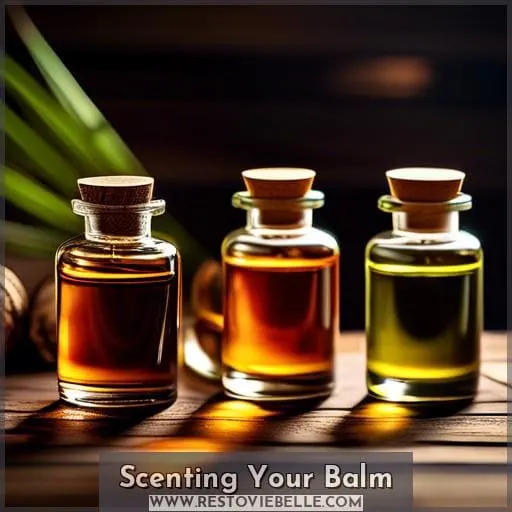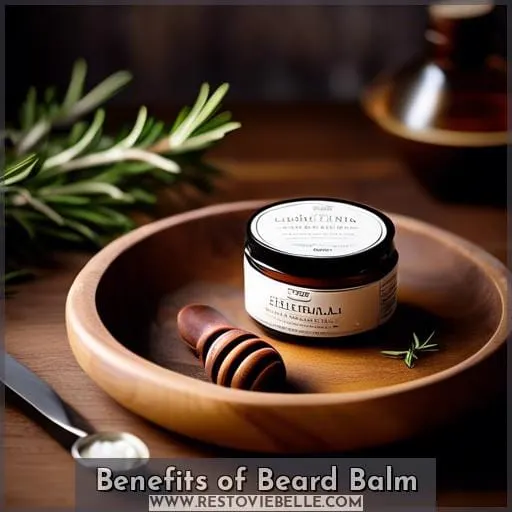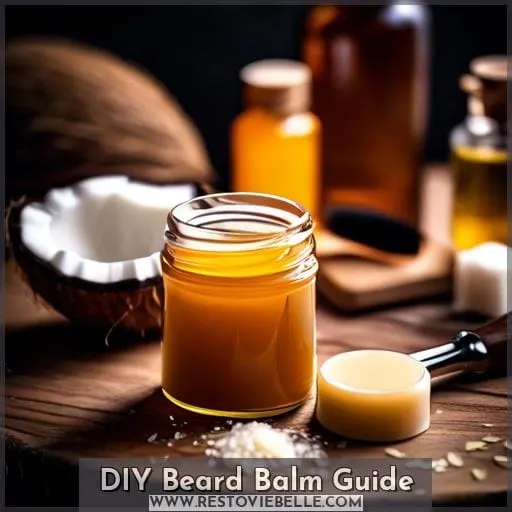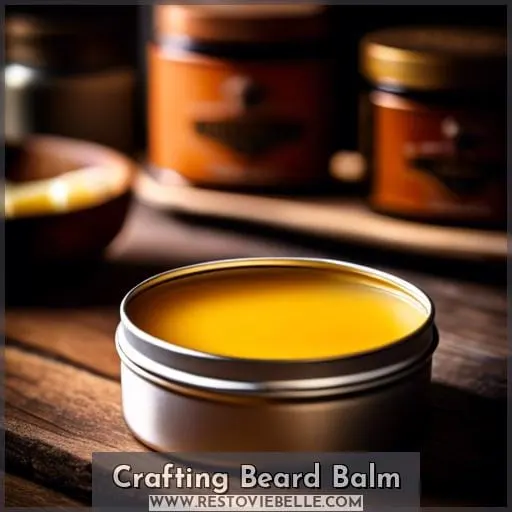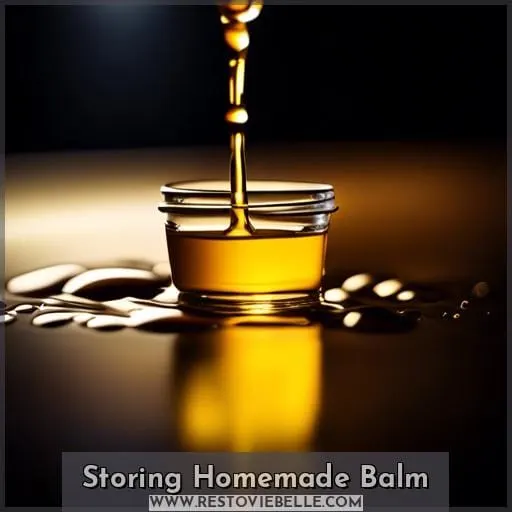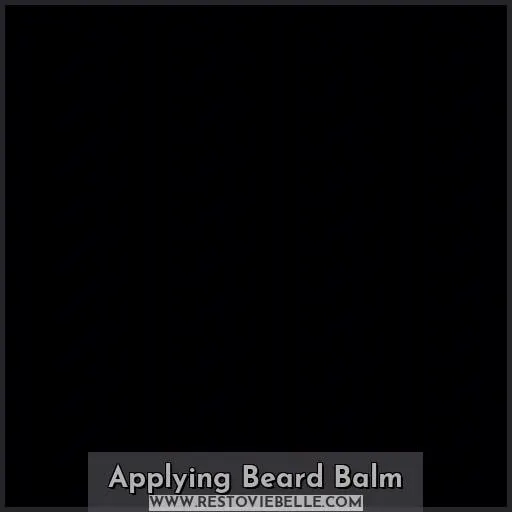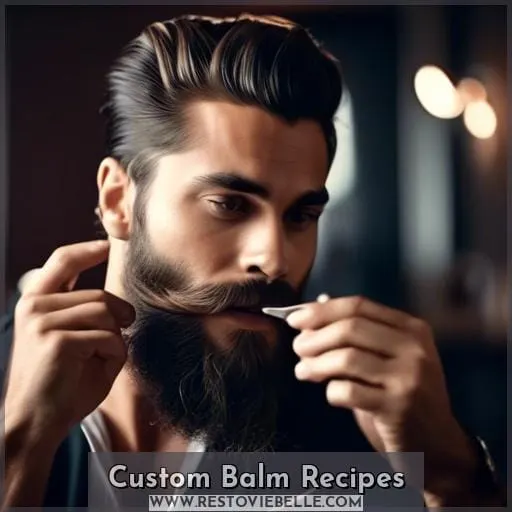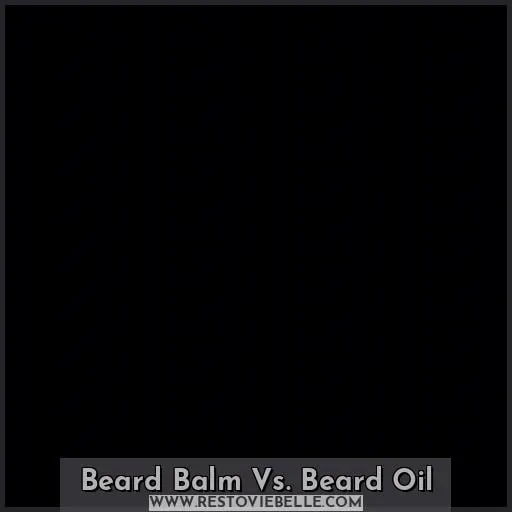This site is supported by our readers. We may earn a commission, at no cost to you, if you purchase through links.
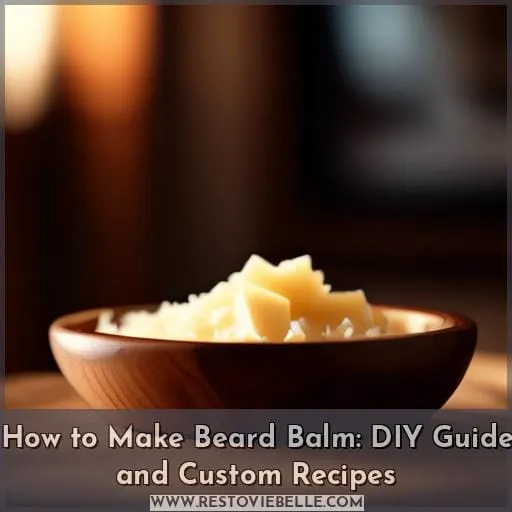 Imagine conquering the unruly wilderness of your beard, transforming it into a masterpiece of style and comfort. With this guide on how to make beard balm, you’ll wield the power to nourish and tame your mane, crafting a custom concoction that whispers of liberation and intimacy.
Imagine conquering the unruly wilderness of your beard, transforming it into a masterpiece of style and comfort. With this guide on how to make beard balm, you’ll wield the power to nourish and tame your mane, crafting a custom concoction that whispers of liberation and intimacy.
Embrace the alchemy of beeswax for hold, butters for texture, and oils for deep nourishment.
Table Of Contents
- Key Takeaways
- Beard Balm Essentials
- Scenting Your Balm
- Benefits of Beard Balm
- DIY Beard Balm Guide
- Crafting Beard Balm
- Top 3 Best Oils
- Storing Homemade Balm
- Applying Beard Balm
- Custom Balm Recipes
- Beard Balm Vs. Beard Oil
- Frequently Asked Questions (FAQs)
- Can I use beard balm on other facial hair, like mustaches or sideburns, for styling or conditioning?
- How do I adjust the recipe if I live in a very hot or cold climate to maintain the consistency of the beard balm?
- Is there a way to test for allergies or skin reactions to the homemade beard balm before regular use?
- Can homemade beard balm be used on sensitive skin, and are there specific ingredients to avoid or include for such skin types?
- How long does homemade beard balm last before it expires, and are there signs that it’s no longer good to use?
- Conclusion
Key Takeaways
- Beeswax provides hold and tames flyaways, making it a key ingredient for beard balm’s texture and styling capability.
- A combination of butters like shea and cocoa butter, along with carrier oils such as jojoba, argan, and sweet almond oil, is essential for nourishment, hydration, and mimicking the skin’s natural oils.
- Essential oils not only add personalized scents but also offer aromatherapy benefits and can elevate the grooming experience.
- Proper storage in cool, dry places using dark, airtight containers can extend the shelf life of homemade beard balm, ideally used within 6-12 months.
Beard Balm Essentials
To embark on crafting your own beard balm, you’ll need to understand the roles of its core components: beeswax for hold, butters for texture, and carrier oils for nourishment. These ingredients work synergistically to create a product that not only styles your beard but also moisturizes and conditions both the hair and underlying skin.
With a basic understanding of these elements, you’re well-equipped to customize your beard balm to suit your specific needs and preferences.
Beeswax for Hold
In crafting your own beard balm, you’ll find beeswax indispensable for its ability to provide a firm hold, essential for styling and maintaining your beard’s shape.
- Beeswax Benefits: Vitamin A-rich, promotes hair health
- Beeswax Properties: Natural, non-toxic, provides structure
- Beeswax Applications: Key in beard grooming products
- Beeswax Uses: Seals moisture, tames flyaways
- Beeswax Alternatives: Candelilla wax for vegans
Butters for Texture
To seamlessly transition from discussing the importance of beeswax for hold in beard balm, it’s crucial to highlight that butters, such as shea and cocoa butter, are frequently incorporated for their texture-enhancing properties.
These natural emollients make the balm spreadable and deeply nourish both beard and skin.
Shea butter adds vitamins and fatty acids, while cocoa butter ensures creamy consistency and lasting hydration.
Carrier Oils for Nourishment
Several carrier oils offer nourishment and moisturization essential for a healthy beard, each with unique properties to enhance your homemade beard balm.
- Jojoba Oil: Mimics skin’s natural oils, high absorption rate, rich in nutrients.
- Argan Oil: Promotes skin benefits, hydrates without greasiness, contains antioxidants.
- Sweet Almond Oil: Excellent for sensitive skin, boosts hydration importance, high in vitamin E.
Scenting Your Balm
After understanding the essential components of beard balm, it’s time to delve into the art of scenting your balm. Aroma selection is a personal and powerful aspect of your grooming routine. By customizing your beard balm with essential oil combinations, you can cater to your aromatic preferences and unlock the potential aromatherapy benefits.
This allows for a unique and intimate experience, empowering you to curate a scent that resonates with your individuality. Whether you prefer woody, citrusy, or herbal scents, the scent customization process offers a liberating opportunity to elevate your grooming ritual.
Below, you’ll find a table showcasing various essential oil combinations for beard balm, providing you with a visual representation of ideas to inspire your own signature scent blend.
| Aromatic Preference | Essential Oils | Scent Blend |
|---|---|---|
| Woodsy | Cedarwood, Pine | Forest Blend |
| Citrusy | Bergamot, Lemon | Citrus Burst |
| Herbal | Rosemary, Sage | Earthy Fresh |
By experimenting with different essential oil combinations, you can create a bespoke scent that not only complements your style but also enhances your overall grooming experience.
Benefits of Beard Balm
Beard balm offers a trifecta of benefits for your facial hair and skin. It not only styles and tames your beard, giving it a polished look, but also moisturizes the skin underneath, preventing itchiness and dandruff.
Moreover, it provides protection from environmental elements, keeping your beard healthy and manageable.
Styling and Taming
Beyond adding a pleasant scent to your beard balm, you’ll find it’s also incredibly effective at styling and taming unruly facial hair. Integrating it into your beard grooming routine enhances your look with minimal effort.
The right homemade beard balm recipe, enriched with essential oils, transforms your beard care tips into a craft.
Moisturizing Skin
In addition to styling and taming your beard, using beard balm will significantly moisturize the skin beneath, preventing dryness and irritation.
- Hydration benefits: Locks in moisture for lasting skin hydration.
- Moisturizing techniques: Utilizes natural ingredients for deep skin nourishment.
- Skin care essentials: Acts as a beard conditioner, enhancing facial hair care.
- Hydrating ingredients: Infused with oils and butters for optimal moisturizing.
Protection From Elements
The moisturizing properties of beard balm soothe your skin and provide a protective barrier against harsh environmental elements like wind and cold weather.
Its protective properties act as a shield, offering environmental defense and weatherproofing benefits.
This outdoor protection is essential for maintaining a well-conditioned beard, leveraging natural grooming products and essential oils for optimal beard conditioning.
DIY Beard Balm Guide
To embark on crafting your own beard balm, you’ll need a few essential tools and a clear understanding of the melting and mixing process.
Start by gathering a double boiler, a scale for precise measurements, and containers for the finished product.
Once you have your ingredients measured and ready, you’ll melt them together, ensuring a smooth blend before adding any essential oils for fragrance.
Tools Required
To seamlessly transition from discussing the benefits of beard balm to the tools required for making it at home, it’s essential to understand that while the advantages of using beard balm are numerous, including styling, moisturizing, and protecting your beard, you’ll need a few basic tools to start crafting your own.
You’ll need a double boiler, a scale for precise measurements, a wooden spoon for stirring, wax paper to protect the balm as it sets, and jars for storage, ensuring your homemade balm maintains its quality over time.
Here’s a quick tools overview:
- Double Boiler: Essential for gently melting ingredients without burning them. If you don’t have one, a heat-safe bowl over a pot of simmering water works as a great alternative.
- Scale: Precision is key in DIY beard balm making. A digital scale ensures accurate measurements of beeswax, butters, and oils.
- Containers: Ultraviolet glass jars or metal tins protect your balm from light and air, extending its shelf life. Remember, tool maintenance and organization are crucial for a smooth crafting process and ensuring the longevity of your tools.
Melting and Mixing
Once you’ve gathered your tools, it’s time to start the melting and mixing process for your DIY beard balm; you’ll need a double boiler to combine the beeswax, butters, and oils. Ensure temperature control to maintain the integrity of the ingredients. Stir gently to achieve a homogeneous blend, integrating the carrier oil and essential oils smoothly.
| Step | Ingredient | Purpose |
|---|---|---|
| 1 | Beeswax | Hold |
| 2 | Butters | Texture |
| 3 | Carrier Oil | Nourish |
| 4 | Essential Oils | Scent |
| 5 | Texture Testing | Consistency |
Crafting Beard Balm
To begin crafting your own beard balm, you’ll combine core ingredients like beeswax for hold, butters such as shea or cocoa for substance, and carrier oils to soften and add texture. Once you’ve melted and mixed these base components, you’ll personalize your balm by adding essential oils, which infuse your creation with unique scents and properties.
This process not only tailors the balm to your preferences but also ensures you know exactly what’s nourishing your beard.
Combining Core Ingredients
After gathering your tools and ingredients from the previous steps, you’re now ready to combine the core components of your beard balm.
- Melting Techniques: Carefully melt the beeswax, butters, and carrier oils using a double boiler. This ensures even heat distribution, preventing any ingredient from overheating and losing its beneficial properties.
- Texture Balance: Achieving the perfect texture is crucial. The ratio of beeswax to butters affects the firmness and spreadability of your balm, allowing for a custom consistency that suits your beard’s needs.
- Ingredient Interactions: As you combine the ingredients, observe how they interact. The right blend of essential oils not only adds fragrance but also enhances the balm’s therapeutic benefits, making your DIY project uniquely tailored to you.
Adding Essential Oils
Once you’ve combined the core ingredients for your beard balm, it’s time to add essential oils. These not only imbue your creation with a pleasant aroma but can also offer additional benefits for the skin and hair beneath your beard.
Essential oils are a key component in crafting a beard balm that’s uniquely yours, allowing for customization in scent and therapeutic properties.
When selecting essential oils, consider their benefits and how their scents will blend together. For a woodsy, masculine aroma, options like cedarwood, sandalwood, and pine are popular choices. Cedarwood, for instance, isn’t only favored for its scent but also for its potential to support hair growth.
For a refreshing, uplifting balm, citrus oils like lemon and bergamot can add a bright note. It’s important to use these oils sparingly; a few drops are often enough to achieve the desired fragrance without overwhelming the senses.
Essential oils not only contribute to the overall scent profile but can also enhance the balm’s skin and hair care benefits, making your DIY beard balm a multifunctional grooming product.
Top 3 Best Oils
When crafting your own beard balm, selecting the right oils is crucial for achieving the desired benefits for both your beard and skin. Among the top choices are African Shea Butter Moisturizing 16 Oz, Organic Cocoa Butter Mary Tylor, and Derma E Vitamin E Skin Oil.
These oils offer a blend of moisturizing, healing, and antioxidant properties that can enhance the health and appearance of your beard.
Incorporating these oils into your DIY beard balm recipe ensures a product that not only styles and tames your beard but also nourishes and protects the skin underneath.
6. African Shea Butter Moisturizing 16 Oz
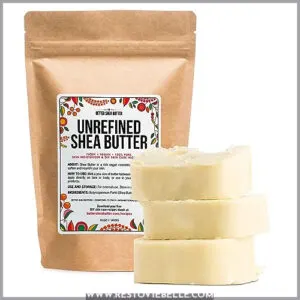
You’ll find that incorporating African Shea Butter Moisturizing 16 oz into your DIY beard balm recipe not only deeply moisturizes your skin but also provides a rich source of vitamins A, E, and F, enhancing cell regeneration and capillary circulation.
This unrefined shea butter, sourced from the nuts of the Shea Tree in Ghana, is celebrated for its nourishing and moisturizing properties. Its natural composition makes it an excellent choice for soothing dry skin beneath your beard, promoting healthier skin and hair.
Moreover, its easy application and ability to soften and detangle hair make it a versatile ingredient in your grooming routine.
- Rich in essential vitamins and fatty acids
- Moisturizes and nourishes both skin and hair
- Supports cell regeneration and improves skin elasticity
- May vary in consistency and scent between batches
- Requires melting for easier application
- Potential for allergic reactions in sensitive individuals
7. Organic Cocoa Butter Mary Tylor
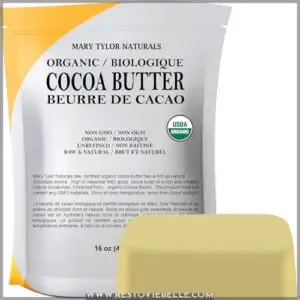
For your next step in crafting homemade beard balm, consider incorporating Organic Cocoa Butter by Mary Tylor Naturals, a top choice for its rich, natural chocolate aroma and high concentration of essential fatty acids.
This premium butter not only deeply moisturizes your skin but also aids in healing scars and burns. Its powerful antioxidants surpass even those in blueberries, making it a potent addition to your balm for robust skin protection.
- Rich in antioxidants, higher than blueberries
- Moisturizes skin and helps reduce stretch marks
- Heals small burns and scars effectively
- Solid at room temperature, may require melting for use
- Chocolate scent may be overpowering for some
- Can separate under different temperatures and climates
8. Derma E Vitamin E Skin Oil
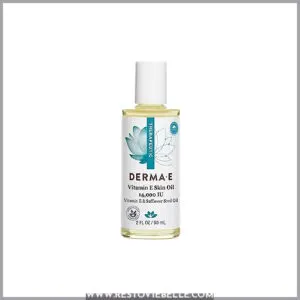
Incorporating Derma E Vitamin E Skin Oil into your beard balm recipe can significantly enhance its moisturizing and healing properties. This oil, rich in Vitamin E, is a powerful antioxidant that nourishes and soothes uncomfortable skin, effectively combating free radicals.
Its ability to deeply penetrate the skin makes it an excellent choice for renewing and repairing damaged areas. Moreover, it visibly reduces the look of fine lines and wrinkles, offering fast-acting moisture and hydration.
This makes it not only beneficial for your beard but also for the skin underneath, ensuring both are kept in optimal condition.
- Deeply moisturizes and nourishes both beard and skin
- Fights free radicals with its antioxidant properties
- Helps reduce the appearance of fine lines and wrinkles
- May feel too oily for some users
- Requires thorough rubbing for full absorption
- Limited scent options compared to other essential oils
Storing Homemade Balm
Once you’ve crafted your homemade beard balm, selecting the right containers and understanding shelf life are crucial steps.
You’ll want to ensure your balm is stored in a way that maintains its quality and efficacy.
These tips will guide you in keeping your beard balm fresh and effective for longer use.
Choosing Containers
When selecting containers for your homemade beard balm, it’s essential to choose ones that will protect the product and extend its shelf life.
- Glass vs. Metal: Glass jars offer an aesthetic appeal and are sustainable, while metal tins are travel-friendly and durable.
- Travel-Friendly Options: Small tins or compact glass jars ensure your beard balm is always within reach, even on the go.
- Size Considerations: Opt for sizes that match your usage; smaller for testing scents, larger for your favorites.
- Sustainable Packaging: Choose reusable or recyclable containers to minimize environmental impact and align with the DIY spirit of making your own beard balm.
Shelf Life Tips
One should always store their homemade beard balm in a cool, dry place to maximize its shelf life. To extend the longevity of your balm, use storage techniques that prevent rancidity. Opt for containers that shield from light and air, as these can degrade organic ingredients.
| Extending Shelf Life | Ingredient Preservation | Storage Techniques |
|---|---|---|
| Dark, airtight jars | Use fresh, quality oils | Cool, dry location |
| Minimal headspace | Antioxidants like Vitamin E | Away from heat |
| UV-protected packaging | Proper sealing | Regular checks |
| Desiccants for moisture control | Rotate stock | Use within 6-12 months |
By following these longevity strategies, your DIY beard balm will maintain its custom recipes’ integrity for longer.
Applying Beard Balm
Once you’ve crafted your homemade beard balm and selected the perfect container for storage, it’s time to learn the proper application technique to ensure your beard looks its best. You’ll want to start by scooping out a pea-sized amount of balm with your thumb or index finger.
- Warm the balm between your palms until it melts.
- Gently work the balm into your beard, ensuring even distribution for maximum moisturizing benefits.
- Use your fingers or a comb to style your beard, incorporating styling tips for a polished look.
- Revel in the scent selection that makes your grooming routine an intimate ritual.
Applying beard balm isn’t just about aesthetics; it’s a moment of self-care that offers skin protection and a chance to indulge in the liberating power of personal grooming. This DIY guide provides you with the tools to create custom recipes that cater to your beard care needs, ensuring your beard remains soft, manageable, and exquisitely scented.
Custom Balm Recipes
Sure, let’s talk about custom balm recipes. In the article How to Make Beard Balm: DIY Guide and Custom Recipes, we’ll explore three unique beard balm recipes: the Woodsman Blend, The Fresh One, and A Night in Italy.
Each recipe offers a distinct scent profile and specific benefits for your beard and skin.
By customizing your own beard balm, you can tailor it to your preferences and enjoy the therapeutic properties of essential oils.
Woodsman Blend
After applying beard balm to keep your facial hair well-moisturized and styled, you might want to explore crafting your own unique blend to further personalize your grooming routine.
The Woodsman Blend, with its woodsy scents of cedarwood and pine, complemented by the freshness of rosemary, offers aromatherapy benefits and DIY customization.
This essential oil blend is perfect for those who appreciate nature’s robust fragrances.
The Fresh One
For a lighter, more invigorating option, you’ll want to try The Fresh One beard balm recipe. This blend is perfect for those seeking a refreshing twist in their beard care routine.
- Scent selection is key; opt for citrus or minty essential oils.
- Ingredient alternatives allow for personalization.
- Emphasizes beard grooming essentials.
- Offers aromatherapy benefits.
- Enhances the DIY guide with custom recipes.
A Night in Italy
Craft your own ‘A Night in Italy’ beard balm by melting together two parts beeswax, two parts cocoa butter, and two parts shea butter. Then blend in one part sweet almond oil and a few drops each of vanilla, orange, and sandalwood essential oils for a scent that transports you to a Mediterranean paradise.
This DIY beard balm recipe infuses your grooming routine with Italian-inspired scents, aromatic ingredients, and a touch of European flair.
Beard Balm Vs. Beard Oil
Transitioning from exploring custom balm recipes, it’s essential to understand the distinction between beard balm and beard oil to tailor your grooming routine effectively. You’ve learned how to craft various balms to suit your beard’s needs and preferences, but knowing when and why to use beard balm versus beard oil can further enhance your beard care regimen.
- Beard balm vs. beard oil: Balm provides hold and styling, while oil primarily conditions.
- Benefits comparison: Balm nourishes and moisturizes both hair and underlying skin; oil is a lighter, quick-absorbing conditioner.
- Ingredient distinctions: Balm contains beeswax and butters for texture; oil is a blend of carrier and essential oils.
- Application techniques: Balm is best for shaping and taming; oil is ideal for a smooth, shiny finish.
- User preferences: Choose balm for control and styling, oil for ease of use and a less greasy feel.
Both products are integral to a comprehensive beard care routine, offering unique benefits. Your DIY guide empowers you to customize these products with essential oils, aligning with your beard care goals and personal scent preferences.
Frequently Asked Questions (FAQs)
Can I use beard balm on other facial hair, like mustaches or sideburns, for styling or conditioning?
Yes, you can use beard balm on mustaches and sideburns for styling and conditioning, just as you would with your beard.
How do I adjust the recipe if I live in a very hot or cold climate to maintain the consistency of the beard balm?
To adjust beard balm consistency for climate, increase beeswax for a firmer hold in heat.
Experiment with ratios to perfect your blend.
Is there a way to test for allergies or skin reactions to the homemade beard balm before regular use?
To test for allergies, apply a small amount of your homemade beard balm to a sensitive skin area, like the inner elbow or behind the ear.
Can homemade beard balm be used on sensitive skin, and are there specific ingredients to avoid or include for such skin types?
Homemade beard balm can be suitable for sensitive skin, especially when made with gentle ingredients like shea butter and jojoba oil.
Avoid sulfates, alcohols, and artificial fragrances, which can irritate.
How long does homemade beard balm last before it expires, and are there signs that it’s no longer good to use?
Your homemade beard balm should ideally be used within a year, as freshness fades beyond this point.
If it smells off, changes texture, or separates, it’s time to bid farewell and whip up a fresh batch.
Conclusion
Embark on a journey of self-expression with your very own beard balm, a beacon of nourishment in the wilds of facial hair.
You’ve mastered the art of blending beeswax, butters, and oils to create a balm that not only styles and protects but also whispers of your unique essence.
With this guide, your beard will thrive, exuding charisma and confidence.
Now, go forth and let your beard balm be the silent narrator of your life’s adventures.
